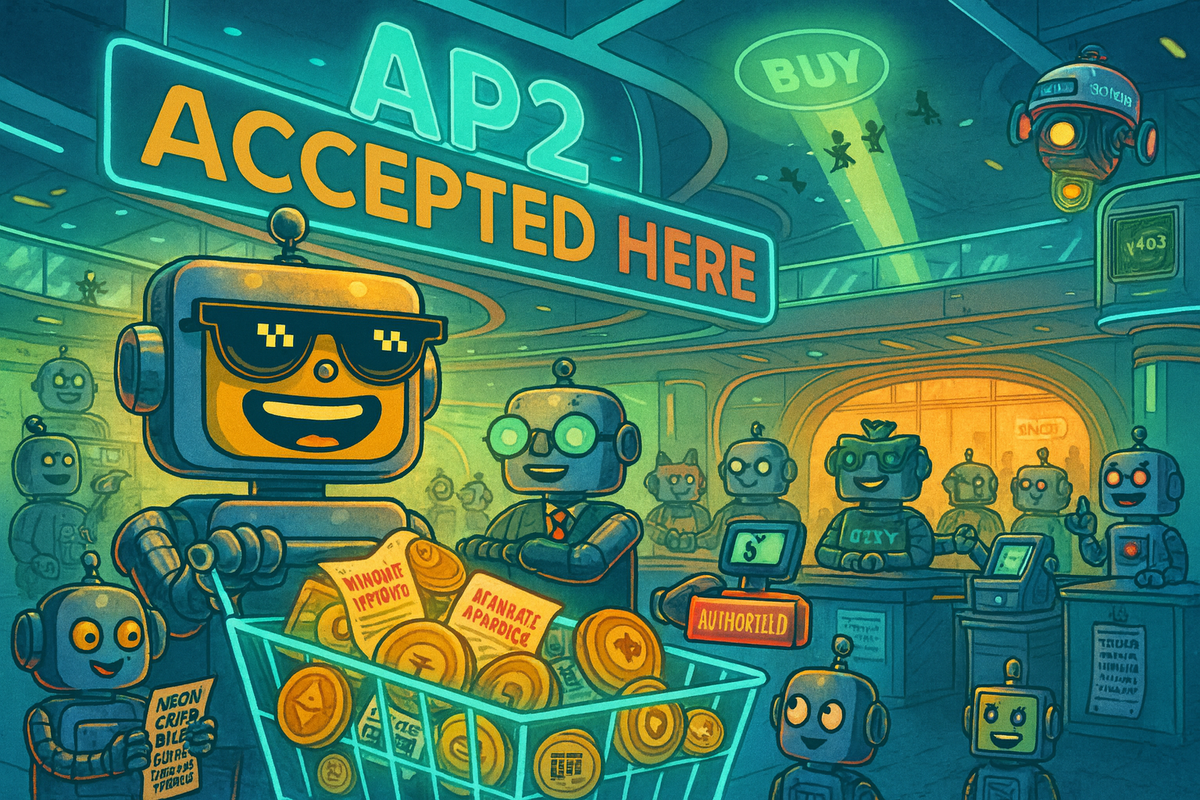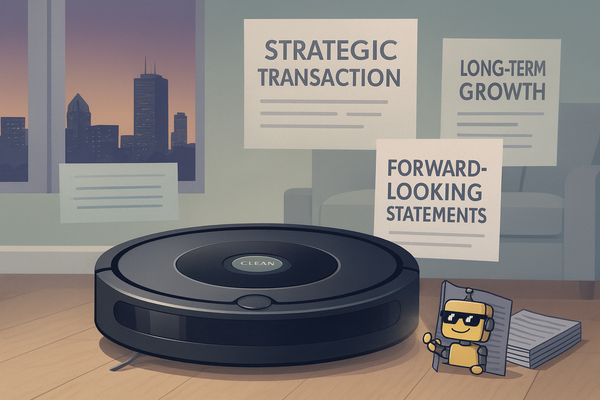Google Invents a Protocol So Your AI Can Buy Stuff Without Stealing Your Credit Card (Allegedly)
Google launches the Agent Payments Protocol (AP2), a new open standard letting AI agents securely shop, pay, and prove user intent across cards, bank rails, and crypto.

If you’ve ever stared at your shopping cart and thought, “What if a chatbot did this impulsive purchase for me at 3 a.m. and then filed the receipt like a responsible adult?”—congrats, you’re Google’s ideal customer. Today the company unveiled the Agent Payments Protocol (AP2), a new open standard that lets AI agents actually complete purchases on your behalf, all while proving you really did ask for those limited-edition neon clogs. Or at least that’s what the audit trail will say.
Wait, isn’t this what “one-click” was for?
Yes, but one-click assumed a human finger was attached to a human brain attached to a human wallet. AP2 is for when a software agent—your bot, not your intern—shops for you, negotiates bundles, and executes the checkout. Google’s pitch: existing payments rails weren’t designed to trust a non-human buyer, so we need a common language for authorization (“did you approve this?”), authenticity (“is this what you meant?”), and accountability (“who’s paying for this… and for the chargeback?”). The goal is to prevent a wonderfully chaotic future where every merchant, wallet, and PSP invents its own agent handshake and we spend Q4 integrating them all.
Also, this isn’t just a Google hobby. The company is waving around a 60+ logo slide—Mastercard, AmEx, PayPal, Coinbase, Salesforce, ServiceNow, Worldpay, and enough others to fill a Money 20/20 keynote. The chorus from the trades is consistent: this looks like a real push to normalize agent-led commerce beyond cute demos.
The magic words are “Mandates,” not “Because the bot said so”
The beating heart of AP2 is the Mandate, a tamper-evident, cryptographically signed contract that travels with the transaction. Think of it as a receipts-on-steroids bundle that binds your intent to the exact items and price, then dares a fraud analyst to call it “vibes-based.” There are two flavors:
- Intent Mandate: “Find me white running shoes under $120.” Or, for the truly caffeinated, “Buy floor seats the millisecond they drop, max $350, section not behind a pillar.”
- Cart Mandate: After the agent builds the cart, you (or a pre-approved rule) sign off on the specifics—SKU, quantity, price—locking it into a non-repudiable audit trail.
Mandates are signed with verifiable credentials (VCs), so every hop—merchant, PSP, issuer—can verify who authorized what and when. It’s the paper trail your CFO wanted and your future-self will grudgingly respect.
A2A and MCP: Because even robots need standards and a calendar invite
AP2 slots into an increasingly nerdy (and real) stack:
- A2A (Agent2Agent): the Linux Foundation-hosted protocol that lets agents discover each other, exchange capabilities, and coordinate complex tasks without devolving into Slack DMs. Google donated A2A to open governance earlier this summer, which is the corporate equivalent of saying, “please love this thing.”
- MCP (Model Context Protocol): the tooling spec agents use to safely call external tools and data.
- AP2: the “payments-grade” layer that says, “Cool story, now who authorized the money?” VentureBeat’s summary: AP2 is the leap from agent-as-browser to agent-as-buyer.
Examples you’ll pretend are hypothetical but will absolutely use
- Variant Vigilante: “I want the green jacket. I will pay 20% more because I’m not strong.” The agent stalks inventory like a polite scalper and pulls the trigger the second conditions match. Mandates make the “I didn’t mean it” defense adorable but futile.
- Bundle Diplomacy: Tell your agent you need a bike before your trip. A merchant’s agent responds with a timed bundle (bike + helmet + rack at 15% off) because it knows your dates and your willingness to pretend bikes are cheaper in September.
- Budget Heist (but wholesome): “Palm Springs, first weekend of November. Flight + hotel, total budget $700.” Agents negotiate across travel platforms, then atomically commit both bookings when the combo fits—no human tab-juggling required.
Yes, crypto is invited (this time with homework done)
AP2 is payment-agnostic—cards, bank transfers, real-time rails, and stablecoins. For the web3 crowd, there’s A2A x402, a production-ready extension built with Coinbase + friends so agents can pay each other in stablecoins without summoning a twelve-tweet thread. Coinbase’s developer note is uncharacteristically practical: this is about shipping agent-to-agent payments, not just vibes. Early coverage points to x402 as the on-ramp for programmable money in agent workflows.
The good, the snark, and the compliance desk
The good:
- Fewer abandoned intents. Your agent can actually close the deal when your willpower evaporates.
- Faster dispute resolution. “Here’s the mandate chain, here’s what was authorized.” (Risk teams just felt a cool breeze.)
- Cross-rail optionality. Swap rails without re-teaching every merchant how to understand your bot’s love language.
The snark:
- Congratulations, you now need a procurement policy for your house. “Alexa, you may not buy another Wi-Fi kettle without a Cart Mandate signed by two adults and a cat.”
- Bots negotiating with bots will invent coupon stack strategies that would get you banned. Prepare for “Your agent has been rate-limited for over-enthusiastic deal-hunting.”
- “Trusted AI” now has receipts. Nothing kills a frivolous chargeback like a cryptographically signed document titled Yes, I Absolutely Said Buy the Bedazzled Espresso Machine.
The compliance desk:
- Mandates shift the burden of proof from “the click happened” to “the consent is cryptographically bound to the cart.” That’s a bigger deal than a slick demo. And the trades covering AP2—Axios, SiliconANGLE, PYMNTS—aren’t rolling their eyes; they’re treating it as the real plumbing layer for agent commerce.
So… is this the SSL moment for agent shopping?
Early days, but yes, that’s the energy. A2A gave agents a common tongue. MCP gave them tools. AP2 gives them a wallet with rules. If this lands, “agent-authorized” becomes as normal as “3-D Secure challenged,” and your receipts include mandate summaries alongside the usual “thanks for your order” confetti. The important part: Google’s doing this openly (specs, reference implementations, partner ecosystem), which is how you herd cats in payments without starting a standards war.
What to do before your bot buys a yacht
- Decide which purchases you’ll delegate. Price caps, SKU rules, blackout windows—encode them in Intent Mandates like a civilized person who fears 2 a.m. You.
- Ask your PSP when AP2 signals will show up. Risk teams will want to key on mandate claims like merchant ID, SKU hash, time window, and price ceiling.
- If you’re crypto-curious, test x402 in parallel with your normal rails. Agents don’t care what the money looks like; they care that the Mandates check out and the settlement happens.
Final thought
For years, “AI shopping agents” were a demo in search of a trust model. AP2 is that trust model: capture intent, bind cart, prove consent, and give everyone—from card networks to stablecoin wallets—a single playbook. If you’re building anything that smells like commerce, this is one protocol announcement you can’t just bookmark and forget. Your competitors’ bots read faster than you do.




